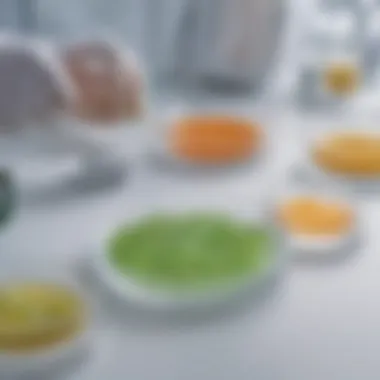Unveiling the Enigmatic Agar Realm in a Petri Dish: A Scientific Exploration


Science Fun Facts
Agar, a substance found in petri dishes, holds key importance in research. Stemming from its origin to varied applications, its role in scientific studies is pivotal. This gelatinous material provides a conducive environment for culturing microbes, allowing scientists to study and observe them in controlled settings.
Discover the Wonders of Science
Scientific concepts ranging from microbiology to environmental science are heavily reliant on agar. Through educational videos and interactive tools, students can grasp the significance of agar in cultivating a multitude of organisms for experimentation. Furthermore, real-life applications showcase the practical implications of agar in various scientific disciplines, sparking curiosity and understanding.
Science Experiment Showcase
Amidst the realms of science experiment showcases, agar plays a fundamental role. Follow step-by-step instructions to create agar plates for bacterial growth, utilizing a list of necessary materials. Safety tips highlight the importance of caution in handling agar, ensuring a secure and educational laboratory experience for all participants. This hands-on approach to exploring agar fosters an appreciation for its ubiquity in scientific research and experimentation.
Introduction
In this article, we embark on a journey to delve into the multifaceted world of agar in a petri dish. The significance of agar in scientific research and experimental processes is profound, serving as a fundamental element in various disciplines. From its historical evolution to practical applications, we will unravel the versatility and importance of agar.
Definition and Composition of Agar
Agar Defined
Agar, a gelatinous substance derived from algae, plays a pivotal role in providing a solid foundation for scientific exploration. Its ability to form a stable gel at a wide range of temperatures sets it apart as a valuable asset in laboratory settings. The unique feature of agar lies in its inert nature, making it an ideal substrate for microbial growth and experimentation.
Composition of Agar
Composed primarily of polysaccharides, agar showcases a blend of agarose and agaropectin molecules, contributing to its gelling properties. The composition of agar grants it the ability to create a supportive environment for various biological specimens, facilitating research and analysis. While agar presents exceptional gel-forming capabilities, its relatively neutral taste and odor make it a preferred choice in scientific investigations.
Role of Agar in Scientific Settings
The role of agar in scientific settings is indispensable, serving as a scaffold for cultivating microorganisms and conducting diverse experiments. Agar's gelation properties provide a stable platform for the growth and observation of bacteria, fungi, and viruses, enabling researchers to study their characteristics effectively. The versatile nature of agar in solidifying nutrient mediums elevates its significance in scientific methodologies, promoting accurate and reproducible outcomes.
Historical Evolution of Agar
Origins of Agar's Usage


The origins of agar's usage can be traced back to traditional Asian cuisines, where it was employed as a gelling agent in various culinary dishes. Over time, its unique gelling properties captured the attention of scientists, leading to its adaptation in laboratory practices. The initial utilization of agar for food preparation laid the foundation for its integration into scientific research, marking a significant transition in its application.
Development of Agar as a Lab Essential
As agar gained recognition for its effectiveness in creating solid growth mediums, it evolved into a laboratory essential for microbiological studies. The systematic development of agar-based techniques revolutionized experimental procedures, allowing for standardized protocols in microbial culturing. The evolution of agar as a lab essential signifies a progressive shift towards more controlled and informed scientific practices.
Landmark Discoveries Facilitated by Agar
Throughout history, agar has played a key role in enabling groundbreaking discoveries in microbiology and biotechnology. Its role in isolating bacteria, identifying microbial colonies, and facilitating genetic engineering procedures has propelled scientific advancements. The application of agar as a facilitating agent in research has led to remarkable breakthroughs, showcasing its invaluable contribution to accelerating scientific progress.
Physical Properties of Agar
Gelation Behavior of Agar
Agar's gelation behavior, characterized by its ability to solidify at room temperature, is a critical aspect of its utility in scientific experiments. The gelation process of agar is reversible, enabling researchers to create and manipulate solidified mediums. This unique property of agar's gelation behavior provides a stable and consistent platform for studying microbial growth and conducting biochemical assays.
Thermal Stability
The thermal stability of agar is paramount in maintaining the integrity of experimental setups, especially during incubation and cultivation processes. Agar's ability to retain its gel structure at elevated temperatures makes it a reliable substrate for sustained scientific investigations. Its thermal stability ensures the viability of microorganisms in culture mediums, facilitating accurate observations and analyses.
Clarity and Hardness Factors
The clarity of agar-based mediums is crucial for visualizing microbial colonies and distinguishing between different species during empirical studies. Agar's innate transparency enables researchers to assess colony morphology and growth patterns with precision, enhancing the accuracy of experimental results. Moreover, agar's optimal hardness factors contribute to the structural integrity of solidified mediums, allowing for secure handling and transport in laboratory environments.
Applications of Agar
Agar possesses a multitude of applications that are indispensable in various scientific disciplines. Its unique properties make it a valuable substance in microbiology, culinary arts, medicine, and biotechnology. Within the context of this article, the significance of exploring the applications of agar lies in understanding its versatility and importance in scientific research and experimentation. By delving into different facets of agar implementation, readers can grasp the breadth of its utility and impact. Not only does agar serve as a solidifying agent, but it also plays a crucial role in fostering innovations across a wide spectrum of fields.
Microbiological Applications
Bacterial Cultures
Bacterial cultures represent a fundamental aspect of microbiological applications of agar. Their contribution to scientific endeavors is profound, aiding in the study and analysis of various bacterial strains. The key characteristic of bacterial cultures lies in their ability to foster microbial growth and provide a controlled environment for experiments. This controlled growth environment enables researchers to observe bacterial behavior under specific conditions, thus facilitating the study of bacterial characteristics and responses. While bacterial cultures are a popular choice for their reproducibility and reliability, one must consider factors such as contamination risks and the need for a sterile working environment. Despite these considerations, the use of bacterial cultures remains essential in scientific investigations using agar.


Fungal Studies
In the realm of fungal studies, agar plays a crucial role in providing a medium for fungal growth and observation. The key characteristic of agar in facilitating fungal studies is its ability to support fungal development while allowing for easy observation and analysis. This aspect makes agar a beneficial choice for studying different fungal species and their behaviors. Researchers appreciate agar's transparency and uniform texture, which aids in studying fungal morphology and reproductive structures. While agar is popular for its consistency and ease of use in fungal studies, limitations such as specific nutritional requirements for fungi must be considered. Despite these considerations, agar remains a valuable tool for studying fungal biology and interactions.
Viral Research
Viral research relies on agar as a substrate for viral culturing and experimentation. The key characteristic of agar in viral research is its inert nature, providing a neutral platform for viral activities. Researchers find agar to be a popular choice for viral studies due to its ability to maintain a stable environment for viral replication and titration. The unique feature of agar in viral research is its support for plaque assays, enabling researchers to quantify viral particles effectively. However, one must consider the scalability challenges of viral research using agar, as large-scale viral studies may require extensive resources and handling procedures. Overall, agar serves as an essential medium for exploring viral behavior and characteristics in scientific investigations.
Innovative Techniques with Agar
In this section of the article, we delve into the fascinating realm of Innovative Techniques with Agar, focusing on its pivotal role in scientific exploration and experimentation. The utilization of agar in innovative techniques serves as a catalyst for groundbreaking advancements across various disciplines. It provides researchers with a versatile and reliable medium to conduct cutting-edge experiments and studies, pushing the boundaries of scientific knowledge.
3D Bioprinting and Agar Matrices
Building Living Tissue Constructs
Building Living Tissue Constructs using agar matrices is a revolutionary technique that enables the creation of intricate biological structures mimicking natural tissues. This method allows researchers to engineer customized tissue models for regenerative medicine, drug testing, and disease studies. The key characteristic of Building Living Tissue Constructs lies in its ability to mimic the complex architecture and functions of living tissues accurately. It serves as a beneficial choice for this article by showcasing the transformative potential of agar in bioengineering.
Research Breakthroughs in Regenerative Medicine
Research Breakthroughs in Regenerative Medicine involve using agar matrices to support the growth and differentiation of stem cells for tissue regeneration. This innovative approach has shown promising results in enhancing the body's natural healing processes and treating degenerative conditions. The unique feature of Research Breakthroughs in Regenerative Medicine is its ability to harness agar's biocompatibility and support cellular proliferation effectively. It is a popular choice for this article due to its profound impact on advancing regenerative medicine paradigms.
Potential Future Applications
Exploring the Potential Future Applications of agar in 3D bioprinting unveils a realm of possibilities for tissue engineering, organ transplantation, and personalized medicine. This approach anticipates using agar matrices to create patient-specific implants, revolutionizing the healthcare industry. The unique feature of Potential Future Applications lies in its forward-thinking approach towards integrating agar-based technologies with advanced medical practices. Despite some challenges, such as scale-up issues and long-term stability, agar presents a promising avenue for future bioengineering endeavors.
Agar Artistry and Creative Expressions
The section on Agar Artistry and Creative Expressions delves into the unconventional yet captivating intersection of science and art using agar as a creative medium. By exploring agar beyond its traditional scientific applications, artists and enthusiasts have redefined artistic expressions.
Agar as a Medium for Artistic Creations
Agar serves as a versatile and intriguing medium for artistic creations, offering artists a unique canvas to unleash their creativity. Its gel-like consistency and translucent appearance add a touch of mystique to artwork, setting it apart from conventional mediums. Agar as a Medium for Artistic Creations stands as a popular choice for this article, highlighting the fusion of scientific material and artistic ingenuity.


Popular Agar Art Exhibitions
Popular Agar Art Exhibitions showcase the diverse expressions and innovations achieved through agar-based artworks. These exhibitions attract art enthusiasts and scientists alike, fostering a cross-disciplinary dialogue on the intersection of art and science. The key characteristic of Popular Agar Art Exhibitions lies in their ability to merge aesthetic appeal with scientific intrigue, captivating audiences with visually stunning creations.
Connecting Science and Art
The collaboration between science and art through agar-based creations bridges the gap between two seemingly disparate fields, encouraging a harmonious blend of creativity and innovation. Connecting Science and Art not only sparks curiosity and inspiration but also fosters a deeper appreciation for the interdisciplinary nature of human expression. This aspect makes it a beneficial choice for this article by showcasing the unifying power of agar in transcending conventional boundaries of creativity and knowledge.
Future Prospects and Conclusion
In the domain of agar in a petri dish, looking towards the future opens doors to innovative possibilities and promising advancements. As technology evolves, so do the applications of agar, with researchers exploring new avenues for its utilization. Additionally, the conclusion of this exploration brings to light the critical role agar plays in shaping scientific endeavors moving forward. By delving deep into the potential future trends, we can grasp the transformative power agar holds within the realm of scientific research.
Emerging Trends and Research Directions
Agar-Based Innovations
Exploring the realm of agar-based innovations unveils a world of cutting-edge methodologies and groundbreaking solutions. One key aspect of agar-based innovations lies in its adaptability across various scientific spheres, showcasing its versatility and efficacy. Researchers find solace in the reliability and reproducibility that agar-based techniques offer, making them a preferred choice for a myriad of scientific experiments. Despite its numerous advantages, challenges may arise in optimizing agar-based innovations for specific research goals, underscoring the importance of continual refinement and adaptation in this evolving field.
Environmental Applications
The integration of agar in environmental applications marks a significant step towards sustainable scientific practices. Its unique characteristics make it an ideal candidate for addressing ecological challenges and promoting eco-friendly solutions. By harnessing agar's properties, researchers can devise novel approaches to environmental conservation and remediation. While the benefits of agar in environmental applications are undeniable, considerations must be made to ensure its sustainable use without adverse environmental impacts, underscoring the importance of judicious application and monitoring.
Integration of Agar in Advanced Technologies
The seamless integration of agar in advanced technologies heralds a new era of scientific possibilities. By amalgamating agar with cutting-edge tools and methodologies, researchers can unlock uncharted territories in scientific discovery. The distinguishing feature of integrating agar lies in its ability to enhance the efficiency and precision of technological processes, revolutionizing the way experiments are conducted and results are interpreted. However, careful evaluation of the reliability and scalability of agar-integrated technologies is essential to leverage its full potential effectively, emphasizing the need for rigorous testing and optimization.
Concluding Remarks
Summarizing Agar's Varied Applications
Capturing the essence of agar's diverse applications underscores its indispensable nature in scientific exploration. From microbiology to culinary arts, agar's adaptability shines through as a versatile ally in research and experimentation. Its inherent properties make it a popular choice in various fields, offering researchers a reliable and practical medium for their endeavors. While summarizing agar's applications unveils its multifaceted nature, continual exploration and innovation are key to maximizing its potential impact across different disciplines.
Anticipated Role of Agar in Scientific Exploration
Anticipating agar's evolving role in scientific exploration sheds light on the transformative journey ahead. The anticipated role of agar underscores its enduring significance as a fundamental tool in scientific inquiry. By embracing agar's potential as a catalyst for discovery, researchers can pave the way for groundbreaking findings and paradigm shifts in their respective fields. Despite the inherent advantages of agar in scientific exploration, it is essential to remain vigilant of potential limitations and challenges, fostering a culture of curiosity and resilience to navigate future unknowns.
Encouraging Further Investigation and Experimentation
Encouraging further investigation and experimentation with agar instills a sense of curiosity and exploration in scientific discovery. By promoting a culture of inquiry and innovation, researchers can push the boundaries of current knowledge and embark on transformative journeys of exploration. The unique feature of agar lies in its ability to fuel curiosity and inspire creative experimentation, leading to breakthroughs and advancements in diverse scientific domains. While encouraging further investigation, researchers must remain cognizant of the ethical and methodological considerations inherent in scientific inquiry, ensuring a balance between exploration and responsibility.







